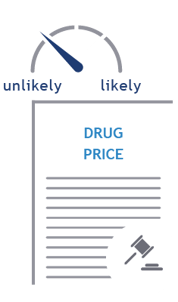Democrats could sweep the November elections according to many independent polls and political experts. What would that mean for the healthcare and pharmaceutical sectors, which have shown sensitivity to the political landscape?
A blue wave isn’t likely to bring transformational policy
Importantly, even in a “blue wave” scenario, Democrats don’t appear likely to gain more than a narrow majority in the Senate. With a narrow majority, the most moderate members of the controlling party tend to set the agenda. I believe transformational progressive policies are less likely in this scenario. That said, Democratic presidential candidate Joe Biden has publicly endorsed several progressive healthcare policies. Below, I break them down and assess their potential impact on the healthcare and pharmaceutical sectors.

|
Expanding the Affordable Care Act
- What it involves: Enticing holdout states (those that have not expanded Medicaid coverage under the ACA) to expand Medicaid coverage with 100% federal matching in the first three years of expansion. It also involves functional reform to strengthen the ACA by reversing Trump administration policies that dampened Medicaid enrollment and exchange outreach.
- Why it matters: Expanding Medicaid provides additional coverage for the uninsured. Eleven states still have not expanded, including highly populated states like Florida and Texas.
- Industry impacts: I believe hospitals would benefit from expanded insurance coverage (increased reimbursement) and government-focused managed care organizations would gain scale and increased negotiating power.
- Likelihood: High. Many policies can be accomplished with executive orders and others could potentially gain bipartisan support.
|

|
Public Insurance Option
- What it involves: The federal government entering the business of providing insurance coverage for any American who wishes to participate. These plans would compete directly with commercial and employer-sponsored plans.
- Why it matters: Proposals are calling for the public insurance option to provide reimbursement rates that closely resemble those of Medicare fee for service. This could cause significant financial hardships across the hospital and provider space.
- Industry impacts: I believe this could be a meaningful negative for hospitals, which could experience a large mix shift from higher-margin commercial payers toward thinner-margin public plans with rates tied to Medicare.
- Likelihood: Low. Hospital lobbying groups are spearheading strong opposition. Additionally, the timing is difficult given the ongoing COVID-19 pandemic and the stress it has added to non-profit and rural hospital systems.
|

|
Lowering Medicare Eligibility Age to 60
- What it involves: Allowing seniors to opt into Medicare coverage at a younger age—60 instead of the current 65.
- Why it matters: People in the 60-65 demographic are heavy users of healthcare services and contribute a large amount to hospital profits. Shifting this age bracket to Medicare from commercial insurance would cause significant financial hardships across the hospital space.
- Industry impacts: I believe hospitals would experience the highest negative impact as the mix shift would reduce earnings power. Managed care would likely be less impacted and could even experience a tailwind from growth in Medicare Advantage (MA) plans.
- Likelihood: Low. Few policymakers may want to add to the financial strains placed on hospitals, especially in light of the ongoing pandemic.
|

|
Drug Price Legislation
- What it involves: Legislation or regulations targeted at reducing drug prices paid by the government and the consumer. Drug pricing reform has bipartisan support, though proposed policies differ.
- Why it matters: The most drastic reforms would allow the government (via Medicare Part B programs) to directly negotiate drug pricing with pharmaceutical companies. Other proposals include measures to reduce prices or force manufacturers to cover patient out-of-pocket costs for drugs (for Medicare Part D programs).
- Industry impacts: I believe proposed reforms could negatively affect branded pharmaceutical companies with high exposures to Medicare Part B and manufacturers with exposure to Medicare Part D.
- Likelihood: Low. Unless the filibuster is eliminated, major legislative action appears unlikely in the near term. However, I believe drug price policy proposals are likely regardless of the election outcome. Headline risk associated with these proposals has the potential to pressure corporate bond spreads for exposed companies.
|
Even without meaningful change, headlines could drive spreads wider
The healthcare and pharmaceutical sectors have two things potentially working in their favor this election cycle: 1) under a blue wave scenario, I anticipate a narrow Senate majority, which would limit the odds of meaningful legislative change, and 2) both sectors have been critical for managing the COVID-19 pandemic—policymakers may be reluctant to damage that relationship. Even so, news headlines, political rhetoric and congressional proposals (such as Medicare for All) have the potential to widen credit spreads. I believe this could create potential buying opportunities in both sectors due to their defensive characteristics and solid fundamentals, including scale and diversity, modestly levered balance sheets and substantial cash flow profiles.

MALR026048
Market conditions are extremely fluid and change frequently.
This blog post is provided for informational purposes only and should not be construed as investment advice. Any opinions or forecasts contained herein reflect the
subjective judgments and assumptions of the authors only and do not necessarily reflect the views of Loomis, Sayles & Company, L.P. Information, including
that obtained from outside sources, is believed to be correct, but Loomis Sayles cannot guarantee its accuracy. This material cannot be copied, reproduced or
redistributed without authorization. This information is subject to change at any time without notice.









